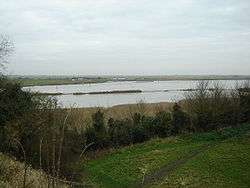Breydon Water

Breydon Water is a large stretch of sheltered estuary at Great Yarmouth in the English county of Norfolk. It is at the gateway to The Broads river system on the eastern edge of Halvergate Marshes. It is the UK's largest protected wetland. It is 5 km (3 mi) long and more than 1.5 km (0.9 mi) wide in places.
Breydon Water is overlooked at the southern end by the remains of the Roman fort at Burgh Castle. Centuries ago, Breydon Water would have been one large estuary facing the sea. At the western end the water may be considered to start at the confluence of the River Yare and River Waveney; smaller sources including The Fleet flow in from the surrounding marshland. Safe passage for boats is indicated by red and green marker posts. Unlike most of the navigable waterways in the Norfolk Broads, Breydon Water is not subject to a speed limit.
At the east end of Breydon Water the river returns to a narrow channel, passing under Breydon Bridge after which it is joined by the River Bure then under Haven Bridge from where it is 4.4 km (2.7 mi) through the harbour into the North Sea.
Breydon Water is a biological Site of Special Scientific Interest[1][2] and a Local Nature Reserve.[3][4]
Features
At low tide there are vast areas of mudflats and saltings, all teeming with birds. Since the mid-80s, Breydon Water has been a nature reserve in the care of the Royal Society for the Protection of Birds (RSPB).[5] It has been a popular shooting area for centuries, and the shooting continues, but on a very much reduced scale.
In terms of nature conservation, Breydon Water is one of the most important estuaries on the east coast of England between The Wash and the Thames estuary. It has specially protected status by virtue of being a European Union Special Protection Area (SPA).
In the winter, large numbers of wading birds and wildfowl use it to overwinter, including 12,000 golden plovers, 12,000 wigeons, 32,000 lapwings and tens of thousands of Bewick's swans. Other species that have been noted there include dunlin, sanderling, whimbrel, several (escaped) flamingos, avocets and on one occasion a glossy ibis.
There is a bird observation hide at the east end of Breydon Water, on the north shore, looking out towards a breeding platform used mainly by common terns. Other breeding species include shelduck, shovelers, oystercatchers and yellow wagtails.
The naturalist Arthur Henry Patterson A.L.S. (1857–1935), who published under the pseudonym 'John Knowlittle', extensively documented the wildlife of Breydon and the disappearing lifestyles of those boatmen, wildfowlers and fishermen who made a living from the estuary. Extracts from his numerous works are available in 'Scribblings of a Yarmouth Naturalist' by Beryl Tooley, his great-granddaughter (ISBN 0-9549048-0-X published 2004.)
The Wherryman's Way and Weavers' Way long distance paths follow the northern bank of the estuary from Yarmouth to Berney Arms, a distance of about 5 miles. Breydon Water is the site of events in the popular Swallows and Amazons series book, Coot Club.
References
- ↑ "Breydon Water citation" (PDF). Sites of Special Scientific Interest. Natural England.
- ↑ "Map of Breydon Water". Sites of Special Scientific Interest. Natural England.
- ↑ "Breydon Water". Local Nature Reserves. Natural England.
- ↑ "Map of Breydon Water". Local Nature Reserves. Natural England.
- ↑ "Waterscape - Breydon Water History". Waterscape.
External links
- Norfolk Broads
- Breydon Water Literary Links
- RSPB Berney Marshes and Breydon Water
- Wherryman's Way long distance walk